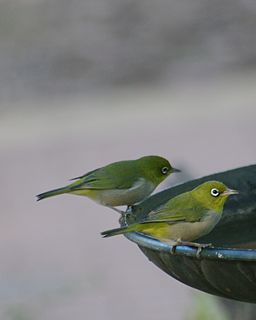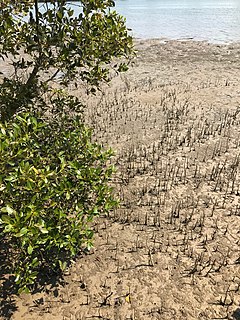Related Research Articles

The Houtman Abrolhos is a chain of 122 islands, and associated coral reefs, in the Indian Ocean off the west coast of Australia. Nominally located at 28°43′S113°47′E, it lies about eighty kilometres (50 mi) west of Geraldton, Western Australia. It is the southernmost true coral reef in the Indian Ocean, and one of the highest latitude reef systems in the world. It is one of the world's most important seabird breeding sites, and is the centre of Western Australia's largest single-species fishery, the western rock lobster fishery. It has a small seasonal population of fishermen, and a limited number of tourists are permitted for day trips, but most of the land area is off limits as conservation habitat. It is well known as the site of numerous shipwrecks, the most famous being the Dutch ships Batavia, which was wrecked in 1629, and Zeewijk, wrecked in 1727.

The flora and fauna of Bermuda form part of a unique ecosystem due to Bermuda's isolation from the mainland of North America. The wide range of endemic species and the islands form a distinct ecoregion, the Bermuda subtropical conifer forests.

The dugite is a species of venomous, potentially lethal, snake native to Western Australia, a member of the family Elapidae.

The Argus monitor is a monitor lizard found in northern regions of Australia and southern New Guinea.
The Lancelin Island skink, also known commonly as the Lancelin south-west ctenotus, is a species of skink, a lizard in the family Scincidae. The species is endemic to Australia.

The Archipelago of the Recherche, known locally as the Bay of Isles, is a group of 105 islands, and over 1200 "obstacles to shipping", off the south coast of Western Australia. The islands stretch 230 km (140 mi) from east to west and to 50 km (31 mi) off-shore encompassing an area of approximately 4,000 square kilometres (1,544 sq mi). The western group is near Esperance and the eastern group at Israelite Bay. They are located in coastal waters, part of which is designated the Recherche Archipelago Nature Reserve.

North Island is the northernmost island in the Houtman Abrolhos, a coral reef archipelago in the Indian Ocean off the coast of Mid West Western Australia. Located about 14 km (9 mi) from the nearest island group, it is one of the largest islands in the Houtman Abrolhos, and one of the few to support dune systems. It has relatively diverse flora dominated by chenopod shrubs and fauna that includes the introduced tammar wallaby, around seven species of reptile, and about 15 resident bird species.
The Abrolhos painted buttonquail is a subspecies of the painted buttonquail endemic to the Houtman Abrolhos. It is common on North Island, and also occurs on other islands of the Wallabi Group, namely East Wallabi, West Wallabi, Seagull and Pigeon Islands.

The western silvereye is a small greenish bird in the Zosteropidae or White-eye family. It is a subspecies of the silvereye that occurs in Western Australia and South Australia. It is sometimes called the white-eye or greenie. Aboriginal names for the bird include jule-we-de-lung or julwidilang from the Perth area and poang from the Pallinup River.

East Wallabi Island is an island in the Wallabi Group of the Houtman Abrolhos, located in the Indian Ocean off the west coast of mainland Australia.
West Wallabi Island is an island in the Wallabi Group of the Houtman Abrolhos, in the Indian Ocean off the west coast of mainland Australia.

The black-backed bittern, also known as the black-backed least bittern or Australian little bittern, is a little-known species of heron in the family Ardeidae found in Australia and vagrant to southern New Guinea. Formerly lumped with the little bittern, it is one of the smallest herons in the world.

The Birds of Western Australia is a book first published in 1948 by Patersons Press Ltd in Perth, Western Australia. Its full title originally was A Handbook of the Birds of Western Australia , though with the publication of the 5th edition only the shorter form was used. It was authored by Dominic Serventy and Hubert Whittell. It was issued in octavo format and contains 372 pages bound in blue buckram with a dustjacket illustrated with a painting of Australian pelicans by Harley Webster. It contains a coloured frontispiece of paintings of the heads of Meliphaga honeyeaters, with numerous black-and-white drawings and maps scattered through the text. The second edition (1951) contained colour plates by Olive Seymour.
Mitchell's water monitor is a semiaquatic species of monitor lizard in the family Varanidae. The species is native to Australia.

Australia has approximately 11,500 km2 of mangroves, primarily on the northern and eastern coasts of the continent. Areas where mangroves occur include the intertidal zone of tropical, subtropical and protected temperate coastal rivers, estuaries, bays and marine shorelines. Less than 1% of Australia's total forest area is mangrove forest.
Diplodactylus fulleri, sometimes called the Lake Disappointment ground gecko, is a species of gecko, a lizard in the family Diplodactylidae. The species is endemic to Australia.
The Exmouth spiny-tailed gecko, also known commonly as Rankin's spiny-tailed gecko, is a species of lizard in the family Diplodactylidae. The species is endemic to Western Australia.
Ctenophorus mckenziei, commonly known as the dwarf bicycle-dragon or McKenzie's dragon, is a species of lizard in the family Agamidae. The species is endemic to Australia.
References
- ↑ "Johnstone, Ronald Eric (1949 - )". BrightSparcs. Retrieved 21 May 2008.
- ↑ Kitchener, D.J.; How, R.A.; Maharadatunkamsi (1992). "A new species of Otomops (Chiroptera; Molossidae) from Alor I., Nusa Tenggara, Indonesia" (PDF). Records of the Western Australian Museum. 15 (4): 729–738.
- ↑ Beolens, Bo; Watkins, Michael; Grayson, Michael (2011). The Eponym Dictionary of Reptiles. Baltimore: Johns Hopkins University Press. xiii + 296 pp. ISBN 978-1-4214-0135-5. ("Johnstone, R. E.", p. 136).
| This article about an Australian ornithologist is a stub. You can help Wikipedia by expanding it. |
| This Western Australia article is a stub. You can help Wikipedia by expanding it. |